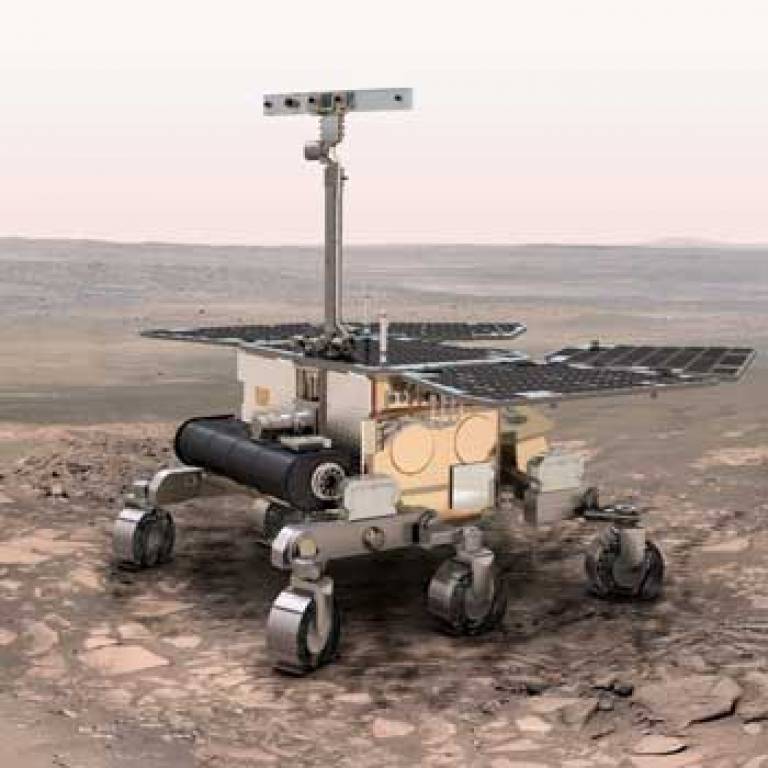MSSL designs 'eyes' of robot scientist bound for Mars
15 June 2010
Links:
 mssl.ucl.ac.uk/" target="_self">Mullard Space Science Laboratory
mssl.ucl.ac.uk/" target="_self">Mullard Space Science Laboratory
A team of scientists from UCL is designing the 'eyes' of a rover that will search for signs of life on Mars.
Professor Andrew Coates from the Mullard Space Science Laboratory (MSSL) is leading the team designing the Panoramic Camera, or PanCam, aboard the ExoMars rover.
Professor Coates's team includes colleagues Craig Leff and Dr Andrew Griffiths from MSSL, Dr Claire Cousins from the Centre for Planetary Sciences at UCL/Birkbeck, and a host of UCL experts and engineers.
ExoMars, a joint mission between the European Space Agency (ESA) and NASA, is a flagship project in the UK Space Agency's science and exploration programme.
The 'robotic scientist' will search for evidence of past and present life and study the local environment of the Red Planet to understand when and where conditions that could have supported the development of life may have prevailed.
Unlike previous US-designed rovers, ExoMars will carry a radar able to search for scientifically promising locations under the surface of Mars and a drill to extract samples from the ground that will be fed to its on-board laboratory.
The PanCam will help guide ExoMars across the rocky surface, be used by geologists to understand the history and structure of the planet, and help identify the best sites for drilling.
Professor Coates said: "PanCam provides the eyes of the ExoMars rover from the top of the mast. But as well as providing the three-dimensional context for all the other measurements on the rover, via stereo and high resolution images, PanCam has important scientific goals of its own.
"First, we will be able to look at the geology of the rocks both near to the rover and far away from it - and also look at the samples from the drill before analysis. This is done by analysing the reflected sunlight with filters - 12 on each 'eye' and three to provide high-resolution colour images. All this can be done from a distance at the rover's vantage point.
"This will allow the ExoMars science team to select the next locations of interest to drive the rover to, and also to decide which of the drilled samples to perform detailed analysis on. In some cases the analytical instruments can only analyse a few samples so it's important to get that right.
"Second, we can use sunrise and sunset on Mars to determine the amount of water in the Martian atmosphere between the Sun and the observation point. This will be important in constraining models of the Martian atmosphere and the all-important presence of water.
"The technical challenges of sending cameras to Mars are significant - off the shelf is not an option due to the space environment (radiation and vacuum) and to the severe temperatures on the Martian surface. A warm day may be 0-20 degrees Celsius but at night it can be as cold as -120, a severe challenge for the team. Our three cameras have to work at -55, survive -120 and not affect the Martian environment.
"So we have designed an optical bench which sits on top of the rover's mast, containing the three cameras and providing a 'planetary protection' barrier to the world (Mars) outside.
"It's exciting that we at UCL lead an excellent and highly accomplished international team, including German, Swiss, Austrian, US and UK colleagues, on one of the key rover instruments. We hope to send back some really inspiring 3D images from Mars."
PanCam is one of nine instruments on board ExoMars,
which is scheduled to launch in 2018.
For more information about MSSL or ExoMars, follow the links above.
Image: ExoMars Rover (Credit: ESA)
UCL context
MSSL is the UK's largest university-based space science research group and delivers a cutting-edge science programme, underpinned by a capability in space science instrumentation, systems engineering and project management.
Related stories:
Stargazing computers mimic human brain
The secrets of Saturn's moons
 Close
Close

